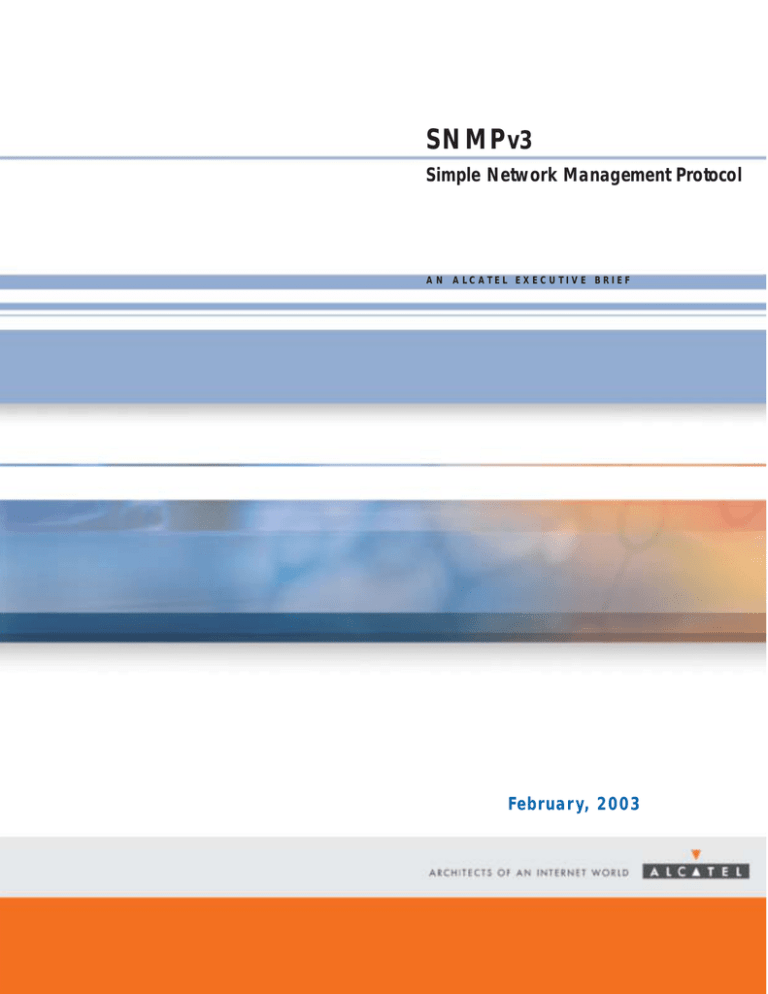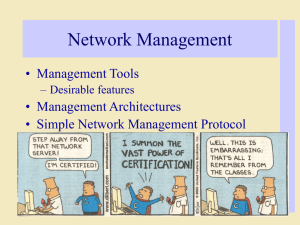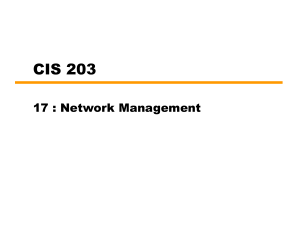SNMP v3 Simple Network Management Protocol Februar y, 2003
advertisement

SNMP v3 Simple Network Management Protocol A N A L C AT E L E X E C U T I V E B R I E F Februar y, 2003 SNMP v3 1. Introduction . . . . . . . . . . . . . . . . . . . . . . . . . . . . . . . . . . .2 2. SNMP Operation . . . . . . . . . . . . . . . . . . . . . . . . . . . . . . .3 3. SNMPv3 . . . . . . . . . . . . . . . . . . . . . . . . . . . . . . . . . . . . .4 3.1. User-based Security Model (USM) . . . . . . . . . . . . . . . . .4 3.2. View-based Access Control Model (VACM) . . . . . . . . . . .5 4. Conclusion . . . . . . . . . . . . . . . . . . . . . . . . . . . . . . . . . . . .5 Appendix A: Abbreviations and acronyms . . . . . . . . . . . . . . . .6 Appendix B: Sources for further information . . . . . . . . . . . . . . . .6 Copyright © 2003 Alcatel Internetworking. The hyperlinks provided in this Executive Briefing are merely for the convenience of our Executive Briefing readers. Alcatel Internetworking, Inc. has no interest in, responsibility for, or control over the linked-to sites. AII disclaims all warranties, expressed and implied, including those of merchantability, fitness for a particular purpose and non-infringement, with respect to the information contained herein, the hyperlinks provided, the information contained therein, and the use thereof. In no event shall AII be liable for any damages resulting from the reader’s use of the information contained herein and/or the hyperlinks provided, even if AII has been informed of the possibility of such damages. P/N 031249-00 2/03 Alcatel Executive Briefing > 1 SNMP v3 1.0 Introduction Network managers need to be able to communicate with and control each element in a network. With the large numbers of devices in networks today, it would be difficult, if not impossible, to manage the network by configuring each device manually. To add to the complexity, most networks contain a mixture of network protocols. Centralized management is the answer. The Simple Network Management Protocol (SNMP) was initially designed as a stop-gap measure for network management until a more sophisticated method could be developed. It was created to allow simple yet effective network management. Despite being created as a temporary solution, SNMP has continued to evolve. Today SNMP is supported by virtually every enterprise network equipment manufacturer worldwide. SNMPv1 (RFC 1157) was effective and easy to implement, but had problems. SNMPv2 (RFC 1902) was developed to add new features and to correct the limitations and bugs of the original. SNMPv2 improved the functionality of version 1, but still did not meet security requirements such as authentication and encryption. SNMPv3 addresses these limitations with the addition of powerful security features including access control, authentication, and privacy of management information. > 2 Alcatel February, 2003 SNMP v3 2.0 SNMP Operation Enhancements to SNMP are modular in nature to allow for gradual evolution of the protocol. The architecture, structure, and framework of all three versions are consistent. The SNMP model consists of a network management station and the devices that are managed, which are called agents. The management station uses User Datagram Protocol (UDP) packets called protocol data units (PDUs) and the SNMP protocol to communicate with devices running agent software. Each network device agent maintains a database called a MIB that contains configuration and traffic information about that network device. The MIB (management information base) is a hierarchal database that the network management software reads and modifies using SNMP commands sent in PDUs. For example, a management station may send an SNMP PDU to an agent to retrieve information about network statistics or to change a parameter in MIB. SNMP offers the following basic functions: Get – The get command retrieves specific information stored in the MIB. An example of this command is, “Get 1.3.6.1.800.4.5.6.” The number that the get command generates is similar to a file number. Every piece of MIB information is identified this way. Get next – Get next is almost identical to the get command, except it requests the next incremental value. For example, one MIB file might show the current number of packets received by a port, which is retrieved by a get. A get next requests the next update. Get reply – A get reply is sent with the information requested by a get or get next command. Set – Set is the command used to configure a device. Trap (or event) – A trap is sent to the management station when a special condition such as start up, shut down, an error, etc., occurs in the device. A network management station uses the get, get reply, and set commands to inspect, configure, and monitor a network device through the MIB. Unlike the other SNMP functions, traps are unsolicited events, meaning that they come directly from a device when it detects a problem. Trap PDUs are typically sent on a well-known UDP port (162) so that any station that is set up to listen to that port receives the traps. Alcatel Executive Briefing > 3 SNMP v3 3.0 SNMPv3 SNMPv3, first defined in IETF RFCs 2271-2275 and again in 3410-3415, is designed to be backward compatible with SNMP versions 1 and 2 and add security in the form of access control, authentication, and encryption to existing SNMP implementations. As such, version 3 is essentially version 2 with the addition of security features and other enhancements. Two of the most significant additions provided by SNMPv3 are the User-based Security Model (USM) and View-based Access Control Model (VACM). 3.1 User-based Security Model (USM) The User-based Security Model (USM) of SNMPv3 defines mechanisms for providing message-level security for SNMP implementations. The USM is designed to protect against threats such as: • Modification of information – changing management information in transit between the SNMP manager and agent • Masquerade – a non-authorized user assuming the identity of a user authorized to perform management operations • Message stream modification – reordering or copying packets in a management message stream for malicious purposes • Disclosure – a non-authorized user accessing a message in transit to learn information (e.g., passwords) contained in the stream SNMPv3 provides authentication, ensures data integrity, and prevents masquerading. After a network manager logs on to a management station with a username and password, SNMPv3 authentication consists of applying MD5 (Message Digest 5) or SHA (Secure Hash Algorithm) to PDU packets using a key. The algorithm produces an authentication value and places it in the message. The receiver applies the same algorithm with the same key and checks if its produced value is the same as the one in the message. The key used for the authentication is associated to the network manager’s user name, which is present within the SNMP message. The authentication functionality ensures that each SNMP message comes from an authorized manager or agent and that it was not tampered with in transit. > 4 Alcatel February, 2003 SNMP v3 SNMP messages are encrypted with DES (Data Encryption Standard) to prevent eavesdropping and ensure privacy of management information. DES uses a key system for encryption. When sending or receiving a message encrypted with DES, both the sender and receiver of the message must have the same private key. This means that data in transit cannot be deciphered without the appropriate key. The USM also has mechanisms for checking the timeliness of SNMP PDU delivery using synchronization and time-window checking techniques. This helps detect messages that have been delayed, which is important because delay is often an indicator that packets have been altered. 3.2 View-based Access Control Model (VACM) The SNMPv3 View-based Access Control Model (VACM) is designed to control access to management information based on a user’s identity. The VACM allows different access levels (read, write, notify) to be defined for different users and for each piece of MIB information. After a network manager authenticates as specified in the USM, all SNMP commands generated carry his/her credentials. SNMP agents check the user’s information against a pre-configured access control database before allowing access to any MIB object. This gives network managers the ability to define different access rights for different administrators. 4.0 Conclusion One of the most significant deficiencies in earlier versions addressed with the standardization of SNMPv3 is the addition of security features. Security including authentication, privacy, and access control, which is of paramount importance in today’s mission critical networks, and SNMPv3 allows network managers to take advantage of SNMP management capabilities without compromising security. Though SNMP was originally created as a stop-gap measure until a more robust network management standard could be created, its simple, modular nature has instead contributed to its longevity. With the edition of security features in SNMPv3, the protocol continues to hold ground in the network management community. Alcatel Executive Briefing > 5 SNMP v3 Appendix A: Abbreviations and acronyms DES Data Encryption Standard IETF Internet Engineering Task Force MD5 Message Digest 5 MIB management information base PDU protocol data unit SHA Secure Hash Algorithm SNMP Simple Network Management Protocol UDP User Datagram Protocol USM User-based Security Model VACM View-based Access Control Model Appendix B: Sources for further information IETF RFC Pages http://www.ietf.org/rfc.html Introduction to SNMPv3 – RFC http://www.ietf.org/rfc/rfc3410.txt?number=3410 The Simple Times http://www.simple-times.org/ SNMPv3 Documentation http://www.ibr.cs.tu-bs.de/ietf/snmpv3/ Want to receive executive briefings like this one every month, delivered directly to your email inbox? Sign up for the Alcatel Information Resource Center today. Visit us on the web at www.alcatel.com/enterprise, call us at 800.995.2612, or email us at end-enterprise-noram-solutions@ind.alcatel.com ARCH ITECT S OF AN INTER NET WOR LD


